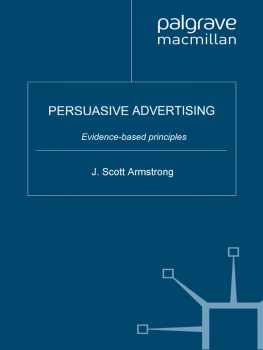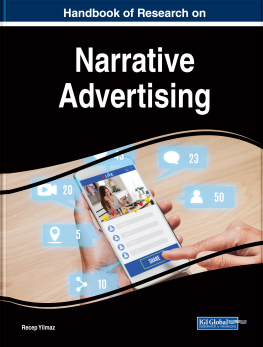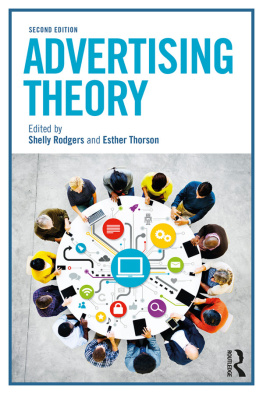Persuasive Advertising
PERSUASIVE
ADVERTISING
Evidence-based principles
J. Scott Armstrong
The Wharton School
University of Pennsylvania
with collaboration from
Gerry Lukeman
Chairman Emeritus, Ipsos ASI
and
Sandeep Patnaik
Research Director, Gallup & Robinson


J. Scott Armstrong 2010
All rights reserved. No reproduction, copy or transmission of this publication may be made without written permission.
No portion of this publication may be reproduced, copied or transmitted save with written permission or in accordance with the provisions of the Copyright, Designs and Patents Act 1988, or under the terms of any licence permitting limited copying issued by the Copyright Licensing Agency, Saffron House, 6-10 Kirby Street, London EC1N 8TS.
Any person who does any unauthorized act in relation to this publication may be liable to criminal prosecution and civil claims for damages.
The author has asserted his right to be identified as the author of this work in accordance with the Copyright, Designs and Patents Act 1988.
First published 2010 by
PALGRAVE MACMILLAN
Palgrave Macmillan in the UK is an imprint of Macmillan Publishers Limited, registered in England, company number 785998, of Houndmills, Basingstoke, Hampshire RG21 6XS.
Palgrave Macmillan in the US is a division of St Martins Press LLC,
175 Fifth Avenue, New York, NY 10010.
Palgrave Macmillan is the global academic imprint of the above companies and has companies and representatives throughout the world.
Palgrave and Macmillan are registered trademarks in the United States, the United Kingdom, Europe and other countries
ISBN 978-1-4039-1343-2
This book is printed on paper suitable for recycling and made from fully managed and sustained forest sources. Logging, pulping and manufacturing processes are expected to conform to the environmental regulations of the country of origin.
A catalogue record for this book is available from the British Library.
A catalog record for this book is available from the Library of Congress.
10 9 8 7 6 5 4 3 2 1
19 18 17 16 15 14 13 12 11 10
Printed and bound in Great Britain by
CPI Antony Rowe, Chippenham and Eastbourne
To my wife, Kay Anderson Armstrong.
My shipmate, partner, and pal for nearly half a century so far. My work on this book was a test of her patience.
For example, Persuasive Advertising traveled with us on all of our vacations over many years.
Her career in social science research and her commonsense approach enabled her to make numerous improvements to this book.
Exhibits
Principles checklists:
1 Information
2 Influence
3 Emotion
4 Mere exposure
5 Overcoming resistance
6 Acceptance
7 Message
8 Attention
9 Still media
10 Motion media
Preface
Advertising is fundamentally persuasion.
Bill Bernbach, 1960
Persuasive Advertising is a guide for all who create or evaluate advertisementsfor people in advertising agencies and advertising research companies, for those who hire agencies, and for those in companies that do their own advertising. The basic proposition is that evidence-based advertising principles underlie persuasion. And experimentation is the bedrock of the knowledge about these principles.
To date, much of what is known about advertising has been hidden in obscure academic papers. The objective of this book is to put useful knowledge about persuasion into an understandable and easy-to-access format. Therefore, I use everyday language. For example, customers think about a product instead of engage in cognitive processing of stimuli.
Many of the principles have profound effects, some of which are counterintuitive. At points in the book, you will have the opportunity to predict the outcome of some of the studies underlying the principles. I hope you will find much evidence that contradicts your current beliefs. Such evidence will be useful to readers who heed Winston Churchills warning, Men occasionally stumble over the truth, but most of them pick themselves up and hurry off as if nothing had happened.
While typical practice and expert opinions are consistent with many of the principles, empirical evidence provides the most valuable support. This book draws upon thousands of research studies that reveal when the principles are most effective and how to apply them.
Understanding evidence-based principles can improve the ability of novices and experts to develop persuasive advertising. It will help advertisers appreciate the challenges that their advertising agencies face as well as contribute to good long-term relationships between sellers and buyers. As you will discover, some commonly accepted practices that appear to be persuasive could be detrimental in the long-term.
Each year advertisers spend enormous sums to market their products and services. Understanding and applying the Persuasive Advertising principles will enable them to accomplish the job of marketing more effectively and at a lower cost.

Acknowledgments
Gerry Lukeman, Chairman Emeritus, Ipsos ASI took an interest in the book starting in November 2006. Over the next three years, he guided me towards the interests of practitioners, provided access to unpublished findings from the files at Ipsos ASI, and greatly improved the organization and clarity of the writing. He was merciless when I lapsed into academic bafflegab. He added examples and provided access to people in the advertising field. His contributions had a profound influence on the book.
Dr. Sandeep Patnaik, Research Director at Gallup & Robinson, took the lead in evaluating the principles by analyzing quasi-experimental data on tested print ads. We were initially uncertain about the value of this project. As it turned out, this original research proved to be immensely valuable. There was a close correspondence between the results of the quasi-experimental and experimental analyses.
The book also presents previously unpublished commercial research. Dave Walker, Senior Vice President, Global Research Director for Ipsos ASI, analyzed data from tested TV commercials. He also helped in summarizing the findings from these data.
Although I never met him, I owe much to David Ogilvy. He translated his knowledge into guidelines that were easy to use. In 1994, I started with Ogilvys guidelines and began the development of a decision-support system for advertising. This led to the conclusion that the guidelines needed to be refined so as to provide a more complete description of the actions that advertisers can take, as well as the conditions under which these actions apply. I refer to these as principles.
I tried to trace the historical development of the persuasion principles. When I discuss historical facts prior to 1930, it is safe to assume that they came from Presbrey (1929). Historical facts from 1930 onwards are from a variety of sources. In many cases, it was difficult to trace the stories to their origins. Many historical facts came from the Internet, often from a number of alternative sources, and these are not cited specifically.
Cynthia Cronin-Kardon, Jean Newland, and others at the Lippincott Library, University of Pennsylvania, tracked down papers no matter how obscure the source or how incorrect the citation. This involved well over 2,600 papers, which were then entered into a data-base, a task that relied on many, and in particular, Amelia Aldao, Michael Guth, Ankita Sancheti, Alexandra Yordanova, and Rachel Zibelman.
Next page










